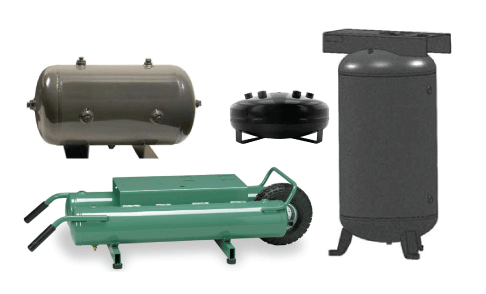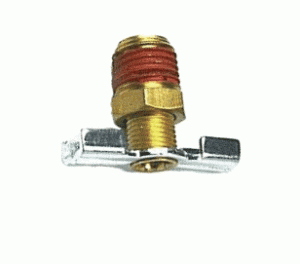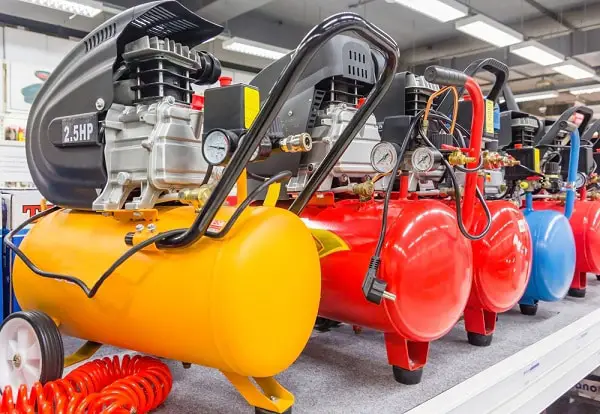I’ve been using my air compressor to blow off my wood planer, about fifteen minutes total use. Now I’m done with my compressor for the day. Do I need to drain the compressor tank?
Did we even know that there is a drain on a compressor tank, and why the compressor tank drain is needed?
Every air compressor will generate water when it’s running. The issues that affect the amount of water that the compressor pump deposits into your compressor tank include;
- the humidity and temperature of the air that’s being taken into the compressor pump
- how hot the pump has become and, by extension, how hot the tank has become
- the amount of time the air sits in the tank and cools
On bigger compressors pump created water pouring into the compressor tank can be measured in tens or hundreds of gallons of water daily. On a smaller, DIY type compressor, not so much, but some water will be dumped into the tank by the compressor pump all the time the pump is running, for sure.

So, what’s the problem with a bit of water in the compressor tank?
Well, actually, there a three main issues.
One is what the water has the potential for doing inside the tank.
Next, what that water can do as some of it exits the tank, along with the air, that’s blowing down the air line to your air tools.
Third, over time, water can fill a compressor tank.
What’s that water doing to the tank?
Compressor tanks are designed, built and pressure tested to resist a certain amount of internal pressure. Typically, this burst pressure is far higher than any pressure that the compressor can generate, as long as the compressor is working properly.
When they are built, the insides of the tank are typically covered with a moisture resistant coating, this to stop water-to-steel contact. It’s my opinion that the lower the price of an air compressor, the less likely that the tank is going to be manufactured to a high standard, and that standard will include the quality of the inside-tank coating.
If water stays inside the tank, it, plus any other material that finds its way into the tank – which can include bits of metal, air intake dust, residue from pump coatings, pump lubricating products… and so on – can react with and affect the tank coating. That water / crud slurry can weaken the tank coating and eventually allow moisture to come into direct contact with the steel in the tank. Rust results.
The tank is a pressure vessel, and anything that can affect the integrity of the tank itself – and that includes a rusting tank – should be avoided. So, that’s what water inside the compressor tank can do. What about the water that exits the tank?
Water flowing out of the tank causes problems too!
What are you using compressed air for? Is it to fill tires? Blow off work benches and machine or woodworking tools, air driven tools, regardless, there are no circumstances I know of where water blowing out of the air line into anything does good.
If there is free water sitting in the compressor tank as fresh air is pumped into the tank some of that air riles up the water in the bottom of tank, and captures it in the air stream. This water, along with the compressed air, flows out of the tank and down the air line to where you are using air.
Water rusts metal. The inside of air tools contain metal. Water will rust the air tools, eventually causing them to seize and result in costly repair.
Water wets what it lands on, including work benches and woodworking or metal working machine tools. It will allow dirt to build up in places on the tool where it is not wanted, and rust metal components of those bench tools.
Do you really want water inside your truck tires?
A compressor tank full of water!
Water enters the tank every time the compressor pump runs. Some of that water blows back out of the compressor tank as air is being used. Much of it doesn’t.
In time, particularly in high humidity areas and days, water will occupy more and more of the tank space. Suddenly your 30 gallon tank becomes 25 gallon capacity, then 20… and so on.
This means that as you are using air, your compressor will have to run more often to keep the tank pressure up, since there is less compressed air available in the tank. The pace for air has been used up by water.
Do I need to drain the compressor tank?
Do you need to drain the tank. Yup, you do.
While strictly speaking you may not need to drain it every time you use the compressor, every couple of days should do.
But, you sure do want to drain the tank after every use if you only use the compressor every once in a while. Don’t leave water in the compressor tank to work away at rusting it out.
Where is the compressor tank drain?
Since tank drains rely on gravity to help them drain water, they will almost always be installed at the lowest point of the compressor tank. The one on your tank may look a little like the one in the image.

You typically cannot see the threaded portion that goes into the tank (threads with red pipe sealant in photo). You normally will see the Tee handle.
There is hole through the handle and up through the drain valve. As the Tee handle is turned, a plug either opens inside the valve to allow water and crud to escape, or the plug is moved into the hole to block the drain.
Don’t necessarily empty the tank completely!
With some air pressure in the tank, turn the Tee on the drain valve to open it. Careful. Sometimes the threads are reversed, so if you cannot turn it one way, assume that it is shut tightly, and turn the Tee handle the other way.
The air pressure in the tank will start to blow the water in the base of the compressor tank out through the drain as the drain is opened. Typically you will hear a hissing and maybe a popping sound as water flows into the drain and out onto… put down some cardboard or some such to catch the water, as it will stain a floor given that it’s not just water coming out.
As soon as the the water stops coming out, close the drain, keeping the remaining air in the tank for the next use. Unless you aren’t planning to use the compressor for a while. Then I tend to drain all the air out and leave the drain open. Just don’t forget to close it before you fire up the compressor the next time, or it will run and run and won’t build tank pressure, and likely you won’t be able to hear that the air is blowing out of the drain as fast as the pump is putting it in the tank, due to the noise of the motor and compressor pump.
Automatic tank drains.
We tend to place our compressors out of the way so that they don’t interfere with work in the shop. That same tendency sometimes makes it very difficult to get to where the drain on the tank is, or worse, get down underneath the compressor to try and see it, and open it.
As a result, some tanks may never get drained. This is not good.
An option to making draining the compressor tank easier is an automatic compressor tank drain. They range in price from $15 or so up to hundreds of dollars, depending on their sophistication and source.
I’ve read some good things about a basic auto-tank drain from Harbor Freight, and a bunch of other sources.
If draining your compressor tank after use is such a pain in the — that you never get around to doing it, spend some money and take the time to install an automatic compressor tank drain. Let it take care of getting all the water out. Just Google buy compressor tank drain to find lots of sources.
Just drain it!
Whether you tend to stick with the manual drain that came with the tank, or opt for installing an auto drain to ensure that you do drain the tank regularly, yes, you do need to drain the compressor tank.
Don’t forget to do so!


If my compressor doesn’t switch off after reaching the 8 bar and seems to be Heavier and won’t switch off from the red button … What is Happening? I bought it 2nd hand and its been great until now so I let it run until its gone right round then switch off and Drain Again before Starting up Again. This doesn’t seem healthy to me but I’ve git about 30 minutes work left to do… 😕🙄 Please advise
Sonia